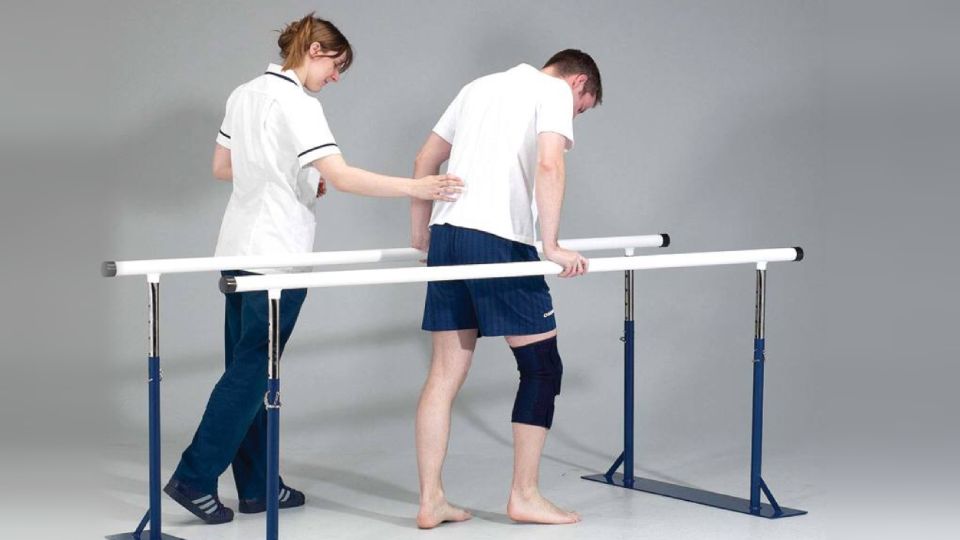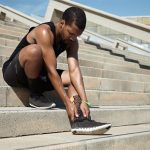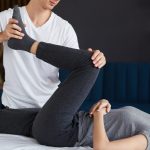Knee replacement surgery is an important step that gives patients a chance for a full life. Rehabilitation after knee joint replacement is no less significant. The quality of future life and the fullness of motor-support functions depend on how the recovery process goes.
Preparing a patient before knee replacement
The consultation of patients who come to the center with complaints of pain and discomfort in the knee area begins with collecting their medical history. The appointment includes assigning necessary diagnostic procedures, and the doctor determines what has caused the damage. Detailed information is needed. Depending on the clinical picture, age, health condition and individual characteristics of the patient, a treatment strategy is determined. If conservative methods do not give results, surgery is recommended to the patient.
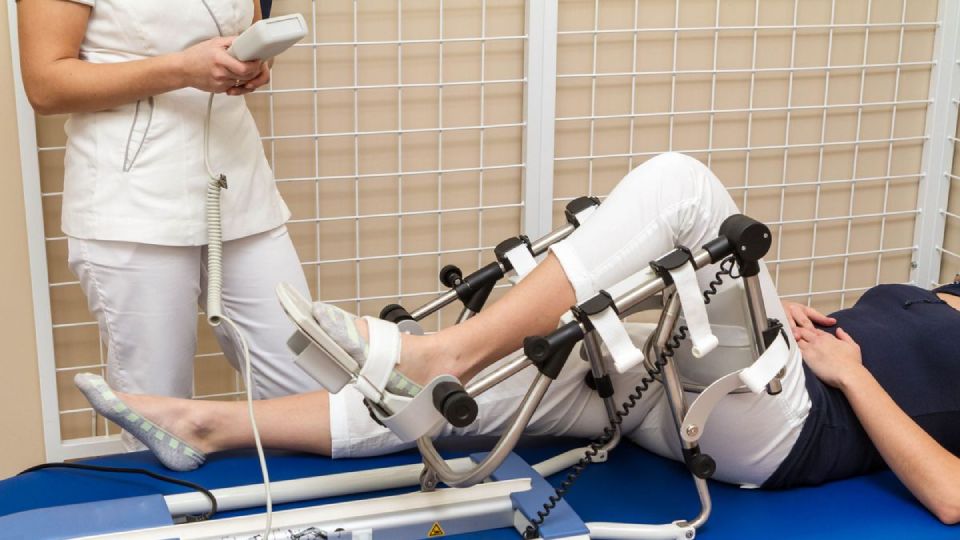
Before surgery, the patient is necessarily prepared for the recovery period. At this stage, the doctor conducts diagnostic procedures and provides consultations. The patient learns to use crutches and a cane, learns methods of movement, and tries to distribute the load correctly when transferring from the bed to a chair. Special attention is paid to arm muscles: they will bear the greatest load after the operation. Considerable strength is needed to hold the body when it is lifted. Patients with obesity are prescribed a diet: extra weight can aggravate the situation.
The most important task before rehabilitating after knee replacement is to strengthen the muscular corset. Special attention is paid to the knee’s muscular framework. A specially designed set of exercises helps to get in shape faster and promotes the quickest recovery after knee replacement. The patient learns the technique of deep chest and diaphragmatic breathing and learns to cough correctly. These measures help to avoid stagnation in the respiratory organs and prevent cardiovascular complications. Among the effective postoperative measures are:
- swimming pool, aqua aerobics;
- performing exercises on a stationary bike;
- Nordic walking;
- A complex of therapeutic physical exercises culture for developing movement coordination.
It is important to know! Common causes of joint damage are arthritis or gonarthrosis. Total knee replacement is indicated when the joint is damaged by 70%. Partial replacement involves replacing the damaged area with an implant. This operation is less invasive.
Rehabilitation after knee replacement: stages and possibilities
Returning to the freedom of movement largely depends on how rehabilitation after knee replacement goes. There are three stages of recovery: early (3 weeks), late (up to 6 weeks), and remote (up to a year). All of them pursue the following goals:
- Managing swelling and pain;
- Restoration of blood circulation, improvement of metabolic processes in tissues;
- Reducing inflammation;
- Improving prosthesis maneuverability;
- Muscle tone balance;
- Restoring the range of motion.
The duration of rehabilitation after knee replacement is individual and depends on many factors: the patient’s condition, age, and adherence to clinical recommendations. Motivation is needed. Success largely depends on the patient’s mindset and his desire to purposefully move towards the goal.
Video: “Postoperative Rehabilitation of the Knee Joint”
Exercises for the knee joint. Set 4A is aimed at strengthening the muscles. Initial stage.
For additional information about postoperative rehabilitation of the knee joint you can watch a video demonstrating exercises and rehabilitation recommendations.
Early rehabilitation period
For the first few days (5-7 days after surgery), the patient is provided with a gentle regimen. The patient is prescribed therapy aimed at alleviating pain syndrome. Adaptation to new conditions takes place. Since the patient has to spend most of the time in a lying position, breathing exercises are included in the therapy. Rehabilitation begins immediately after the intervention. The healthy leg is loaded with exercises to strengthen the hip, knee, and ankle joints. At the same time, they give a feasible muscular load on the operated limb. The leg is placed on a functional splint, gradually increasing the bending angle in the prosthetic area. These approaches are performed several times a day. In the exercise program, the following is recommended in the first days after surgery:
- Quadriceps training. The patient straightens the knee to the maximum, raises the leg by 30-40 cm, and holds it for 2-3 seconds. It should be performed 10 times a day.
- Footwork. Every 5-10 minutes, the patient performs slow bending and unbending in the ankle.
- Knee straightening. A physical therapist places a roller under the ankle, with the foot suspended. When the quadriceps muscle contracts and the knee is fully extended, the roller is removed, holding the leg in this position for 5-10 seconds.
- Bending with support on the bed. The patient slides the heel along the bed towards the thigh, bending the leg at the knee as much as possible. The bent knee is held in position for 5-10 seconds.
- Training the posterior thigh muscle group. The leg should be bent at the knee at a 30-degree angle, with pressure on the heel. Maintain tension for 5-10 minutes.
- Hip lift. Bend the healthy leg at the knee, with support on the foot. Arms along the torso, the operated leg is straight. The pelvis should be lifted from the bed.
- Lifting the upper part of the torso.
- Back arching. Support on the bent elbows, the back of the head, and the pelvis.
- “Cycling” with the healthy leg.
- Mechanotherapy devices for passive development of the damaged area.
In the next days after total knee replacement, the exercise complex is expanded, and the load is gradually increased. Alternating active and passive exercises positively affects the dynamics of movements. The patient gets up with support on the walker, and under the supervision of an instructor, learns to walk. The posture is straight and correct. Later, walking on stairs and running on a suspended treadmill is added. To improve the patient’s condition, the doctor prescribes additional procedures, which include physiotherapy and massage, and physical therapy techniques. The device is still actively used.
Physiotherapy at the center is aimed at improving lymph flow, blood circulation, and bone structure regeneration. For recovery after knee joint arthroplasty, electromyostimulation, electrophoresis, ultrasound therapy, UHF, MBST, laser beam, and blood plasma treatment are most often prescribed. As a result of a comprehensive approach, rapid tissue regeneration occurs around the endoprosthesis, and limb mobility improves.
Important! To prevent thrombosis, the doctor prescribes anticoagulant therapy. The choice of medication is solely at the doctor’s discretion, and self-treatment in this case is dangerous. Also As well, the use of compression hosiery is indicated during the first two months.
Late-stage rehabilitation
This stage is also called “home-based” since rehabilitation after knee joint replacement surgery continues at home after discharge from the hospital. The main task of the patient at the late stage is to find a competent doctor and regularly perform the recommended physical exercises. The speed of recovery and the ability to return to a normal lifestyle depend on these conditions. The recovery process takes quite a long time. A good effect is achieved given by video complexes of therapeutic exercises developed by specialists, taking into account the physical needs of patients with total joint replacement. The duration of each exercise depends on the specifics of the problem. A selection of therapeutic physical culture videos allows you to perform exercises at home while sitting, lying, or standing near support means. You should start with minimal stress. For that, you can use a set of exercises for the lower limbs, implying the initial stage of rehabilitation. The video course is convenient because it can be used both at home and in any other place. It is enough to turn on the player on a computer, laptop, or phone.
When the body gets used to the loads, it is time to move on to the intermediate level of training, consisting of eight exercises. Changing the load is an important stage of rehabilitation. You can also choose other video complexes that influence different areas of the body: the workout will be as useful as possible. And the final stage will an advanced stage, which includes a series of exercises for the maximum rehabilitation effect. All three complexes are an affordable technique for those who dream of regaining their full health. To evaluate the result, you can use a free service: for five days, the function of testing video materials is available. If desired, you can purchase your preferred version of the video. The cost is affordable for everyone. A bonus is a discount on a subscription for three months or more. Those who have been using ready-made videos for a long time note a significant improvement in their condition.
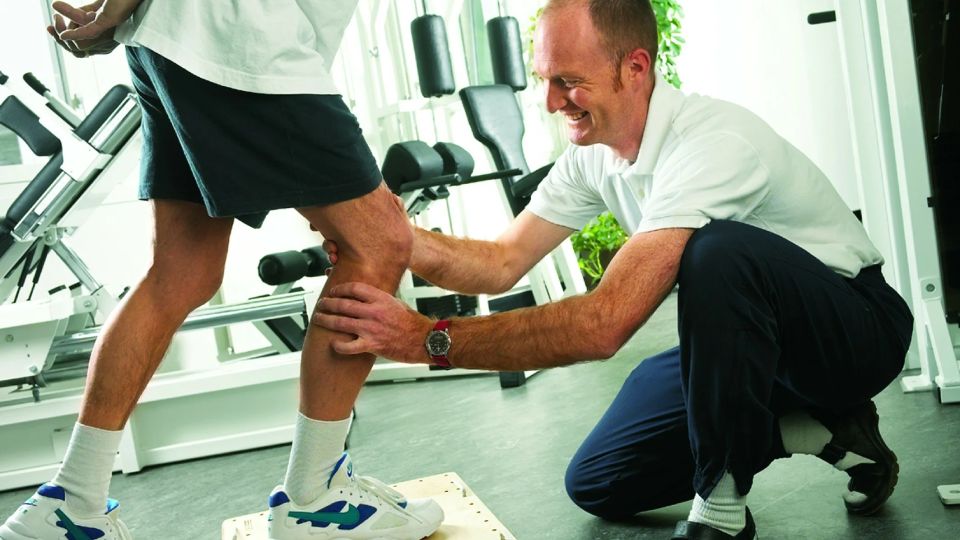
After 5-8 weeks post-surgery, movements become stable, and the bending angle should exceed 90 degrees. If this does not happen, it is essential to change the technique. After two months of rehabilitation, it will be impossible to increase the range of motion. The priority is to activate work on the bending volume in the knee and, if possible, continue exercising on the Arthromot device. The longer the patient trains by himself, the more confident he feels.
By the end of the second month after surgery, the patient still uses crutches, but more as a safety measure. This is the stage when you can give up crutches to fully improve walking skills. If it is initially uncomfortable without support means, you can temporarily use Nordic walking poles.
While performing leg exercises, it is essential not to forget about other body parts. At the late stage of rehabilitation, daily home workouts include exercises for the back, arms, abs, and breathing exercises. The course is conducted comprehensively and helps restore lost functions.
Passive-active exercises gradually strengthen muscles, ligaments, tendons, and make the endoprosthesis more mobile. However, it is impossible to achieve stable results and join “happy” patients without changing your lifestyle. Static-dynamic indicators will improve if you regularly take walks for 40-60 minutes a day. After eight weeks, if the recovery proceeds without complications, you can step on the leg with a 50-percent load. By the end of the rehabilitation program (which lasts 12 months), the leg with the replaced joint can easily withstand a 100-percent load.
Important! On average, rehabilitation after knee joint arthroplasty lasts from 3 to 6 months. The maximum recovery period is one year. Joint mobility can recover even earlier. It does not mean that you should stop exercising after this stage: you need to maintain leg health for a long time, continuously. Physical activity should become a part of your life.
Complications after surgery
With adherence to the orthopedist’s clinical recommendations, the risk of complications is minimal. After completing rehabilitation, patients usually recover quickly. However, it is essential to understand that the endoprosthesis is a complex structure, and its improper use and excessive loads can lead to significant problems. Possible complications during the recovery program include:
- development of purulence;
- accumulation of exudate in the damaged capsule;
- soft tissue inflammation;
- thrombosis;
- adhesive process;
- prosthesis dislocation;
- allergic reaction to the implant material.
Please note! The success of the rehabilitation program largely depends on the condition state of the blood vessels. Good blood flow plays an essential role in joint function recovery, nourishes tissues, and improves metabolic processes. A condition for successful recovery is to quit smoking and alcohol consumption.

Recommendations for patients
Knee joint arthroplasty (KJA) is a massive stress for the body. However, if indicated, it is necessary to undergo the procedure. Rehabilitation after knee joint replacement should be carried out under the close attention of a specialist. To avoid trouble and minimize pain and unwanted side effects, it is essential to follow expert recommendations at home:
● In the postoperative period, it is crucial to carefully monitor your health. Any infections, exacerbations of chronic diseases, or overcooling can cause joint inflammation. An increase in temperature, a change in the appearance of the operated area, redness, or swelling are direct indications to see a doctor. It is essential to undergo a timely examination to eliminate the problem.
● After arthroplasty, it is necessary to avoid overly active sports – running, aerobics, contact games, and ball games. They should be replaced with less intensive gentler activities. Physical activity should be dosed. Benefits will come from Nordic walking, swimming, calm tourism, cycling, ballroom dancing, skiing, and climbing low stairs.
● Recovery after knee joint replacement excludes lifting weights over 10 kg.
● Recovery after knee arthroplasty implies choosing shoes with low heels. In winter, during icy conditions, it is necessary to use support means attachments to prevent slipping.
● During the rehabilitation after knee joint replacement, it is better to remove slippery objects, carpets, wires, and various obstacles from your way path. The conditions for moving around the house should be as comfortable as possible.
● The surface the patient sits on should not be lower than knee level. During standing up and squatting, avoid sudden movements. After 15-20 minutes of sitting, it is necessary to change the body position. It is also not recommended to stand in one place for half an hour.
● After a walk, it is advisable to lie down and keep your legs elevated for half an hour. During rest, you can place a pillow between your legs. Alternating rest and wakefulness will relieve the load on the joint.
● Any excess weight is an additional load on the operated organ. An individual diet is selected.
● Visiting a sauna or steam bath is contraindicated for three months after the intervention. Refrain from hot baths and showers for six months.
● If there is a difference in leg length after TKA, you need to choose heel lifts – for the prevention of osteochondrosis, neck and lower back problems. Orthopedic insoles will help with foot defects.
Useful information! The average service life of a knee prosthesis is 25 years. As the operation is most often performed in old age, the chance of replacing the implant is almost nil.
Making a decision about KJA is a responsible task. The rehabilitation and recovery process after knee joint replacement will go perfectly if you start preparing long before the surgery. The hope for a successful outcome of the prosthesis, the desire to join healthy people as soon as possible, will undoubtedly result in an excellent result. We successfully restore the functionality of damaged limbs. The center has the necessary equipment for knee joint replacement and rehabilitation. After all, it is so important to feel confident, have a smooth light gait, and stand firmly on your feet.
conclusion
Check out the demo version of our sets of exercises for the Lower Limb Problems on YouTube.
You can find more information about the Lower Limb Problems in our Library of Articles.
Our website presents sets of exercises for rehabilitation of the knee joint in the following areas:
-
EXERCISES FOR THE KNEE JOINT. SET №3 IS AIMED AT STRETCHING THE MUSCLES (IMPROVING THE FLEXIBILITY OF THE MUSCULAR APPARATUS) AND INCREASING THE RANGE OF JOINT MOVEMENT
-
EXERCISES FOR THE KNEE JOINT. SET 4A IS AIMED AT STRENGTHENING THE MUSCLES. INITIAL STAGE
-
EXERCISES FOR THE KNEE JOINT. SET 4B IS AIMED AT STRENGTHENING THE MUSCLES. MID STAGE
-
EXERCISES FOR THE KNEE JOINT. SET 4C IS AIMED AT STRENGTHENING THE MUSCLES. ADVANCED STAGE
In addition to the listed sets of exercises in the Lower Limb Problems section there are sets of exercises for the rehabilitation of the ankle joint, pelvic girdle and hip joint

